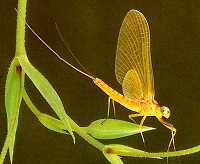The Yellow Drake Mayfly Spinner
The Yellow Drake Mayfly fly Spinner fishing pattern has a deserved reputation for producing great hatches that can entice large lurker trout to leave their lays and feed greedily on the hatching Drakes. When they do hatch their emergence is not a subtle event.

FANWING MAYFLY SPINNER DRY FLY PATTERNS. Hook size 12 16 - $US each
When a mayfly nymph rises to the surface, splits open and the adult mayfly emerges with upright opaque wings, fly fishermen call the insect a mayfly dun and imitate it with dry fly surface patterns that have upright wings. These mayfly duns soon fly off the water surface as soon as their wings have gained strength and dried. They land on streamside vegetation where they eventually shed their skin for the final time and become mayfly spinners.
The spinners gather together over the water in swarms where they mate, lay eggs and fall back to the water surface spent. They have no energy left so they float on the surface film with their wings horizontal and flattened. A mayfly dun hatch can occur over a number of weeks but a mayfly sinner swarm, mating and fall often happens all at once within a one hour period. It can result in a feeding frenzy where the water boils with the activity of munching trout. Compared with mayfly duns, spinners have long tails and, slim bodies and larger translucent wings. Fish them dead drift over the feeding zone. Make sure your presentation is drag free otherwise you will scare away your target trout. The spinners are either dead or dying. Your fly should not move other than being slowly drifted downstream, caught in the water surface film. Any unnatural movement will spook the fish.

Yellow, Green and Brown Drakes are not the largest mayflies of the summer hatches but they are certainly much bigger than the early Blue Winged olive and Blue Dun hatches of early spring. They belong to the Ephemeridae family mayflies. They have all a deserved reputation for producing great hatches that can entice large lurker trout to leave their lays and feed greedily on the hatching Drakes. When they do hatch their emergence is not a subtle event. After breaking through the surface film and their nymphal shucks these large duns struggle frantically to get off the water. This makes them very conspicuous and easy prey for both birds and trout. They float for long distances waiting for their wings to fill with blood. When the wings are fully inflated and dry these duns flutter furiously as they try to lift their large bodies into the air. This fluttering action often is the trigger for some violent strikes.
As nymphs all three species prefer slow moving water that has a river bed of fine sand, gravels or silt. During a hatch you will find the greatest concentration in these same areas. The slow moving water gives the trout a very clear view of it's target. The Yellow Drake is the last of the three Drakes to emerge. Their hatches are normally in the middle of June and extend up to the middle of August. They can be found in freestone as well as limestone rivers. The are sometimes referred to as the 'Warmwater Drake' Summer low water conditions and rising water temperatures do not appear to upset them. they just emerge later in the day. Large concentrations are rarely seen on the water. They emerge sporadically but the trout and bass know it is Yellow Drake hatch time. Drift a Yellow Drake fly over a quiet pool in the early evening and see what happens. Be ready to set the hook.
CUSTOMER'S COMMENT
I find that trout can become a bit wary of large mayfly dun patterns, like the Yellow Drake, suddenly falling from the sky in front of it's face. They get spooked and dart away. I Like to cast well upstream of my target fish and let the fly drift past the trout's observation window just like the natural insects. I try to be upstream of the fish so it has less chance of seeing the leader. Using such a large fly can cause problems to the novice angler. Do not tighten up the line too soon. The timing of your 'strike' is very important. Wait until the head goes down with the fly in its mouth to get a better chance of a hook up. - James Hamilton
Fly Fishing books



